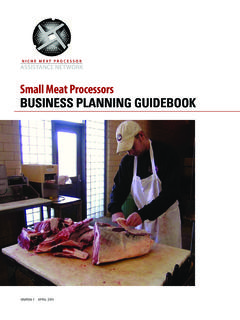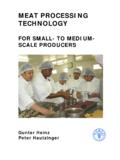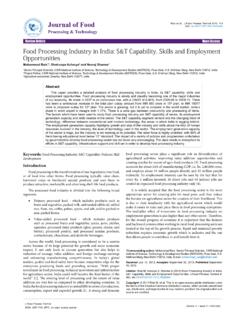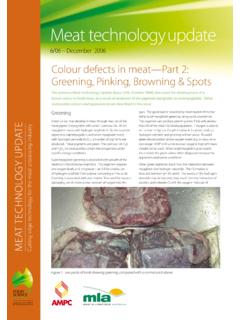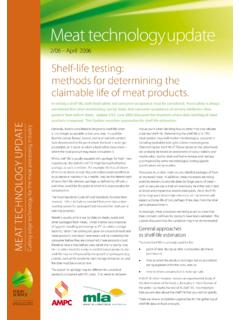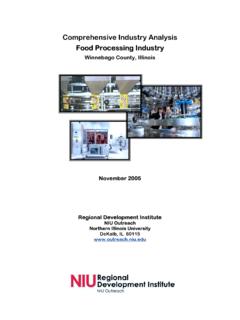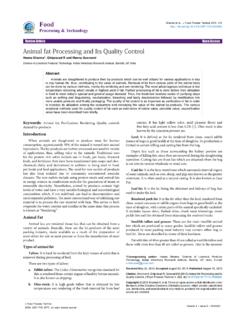Transcription of Small Meat Processors BUSINESS PLANNING …
1 NMPAN 1 APRIL 2011 Small Meat Processors BUSINESS PLANNING GUIDEBOOKAUTHORSL auren GwinNiche Meat processor Assistance Network (NMPAN)Oregon State UniversityArion ThiboumeryNiche Meat processor Assistance Network (NMPAN)Lorentz MeatsIowa State University*Debra GarrisonAgricultural ConsultantNick McCannNational Center for Appropriate Technology (NCAT)Appropriate Technology Transfer for Rural Areas ACKNOWLEDGMENTSS upport for this guide was provided by the Department of Agriculture, Rural Development, and eXtension, a national initiative of the combined land-grant university system. NMPAN is a Small meat Processors community of practice within thanks to our reviewers for their significant improvements to this guide NMPAN s Advisory Board Niche Meat processor Assistance NetworkThis guide may be reproduced in its entirety for informational, noncommercial purposes.
2 Otherwise, no part of this guide may be excerpted, reproduced, or utilized in any other form, by any means: electronic, mechanical, photographic or a recording, nor may it be stored in a retrieval system ( , on a website), transmitted or otherwise copied for public use without prior written permission from:Niche Meat processor Assistance Network 213 Ballard Extension HallOregon State UniversityCorvallis, OR 97331 This publication may be downloaded online as a free PDF from *publishing TO USE THIS 1 Brief Introduction to BUSINESS Plan 2 ABC Meats BUSINESS Plan, Piece by Executive BUSINESS BUSINESS Mission and Markets and Marketing Appendix Appendix Appendix Appendix Appendix Appendix SECTION 3 Considerations for Other Plant 4 BUSINESS PLANNING 5 A Final Table of CONTENTS23577910111316171822242424252736 3712 Small Meat Processors BUSINESS PLANNING GuidebookINTRODUCTION This guidebook walks you through creating a BUSINESS plan for a Small meat processing facility.
3 The example used is a real BUSINESS plan, written by an existing Small processor to obtain bank financing for a significant expansion and retooling of his BUSINESS . Names and other identifying details have been changed for is a BUSINESS plan? A BUSINESS plan is a living document in which you clearly state the goals of your planned BUSINESS venture, provide reasons that these goals are achievable, and outline your plan to achieve your goals. When does a processor need a BUSINESS plan? To put it another way, when do you not need a BUSINESS plan? Answer: when you can afford to fail. Unless you re PLANNING a meat processing BUSINESS as a hobby, you need a BUSINESS plan. Your banker will require projections of revenue and cash flow with concrete information to back up these numbers.
4 At a minimum your BUSINESS plan is for your bank. But your BUSINESS plan is also for you. It can be daunting to put a BUSINESS plan together. But the process of PLANNING your BUSINESS trying to figure out how it will work and whether you re going to make money is essential. Admittedly, almost no BUSINESS runs exactly as a BUSINESS plan projects. But it is far better to lose money on paper than to lose money in real life. What is your plant going to cost? How many employees do you need, and how much can you afford to pay them? What prices will you charge? Where will the livestock come from, and how do you know they re coming? These are all questions you need to answer before you take out a $1 to 2 million loan and start paying it back every month for 25 years.
5 Putting together a BUSINESS plan shows you are serious about starting or expanding and have thought through the is not covered in this guide?This guide does not cover all the different regulations relevant to building and operating a processing facility. It is critical to understand the regulations at the federal, state, and local levels before you finalize your plans. Make sure you understand the pros and cons of different types of inspection (federal, state, custom-exempt, retail-exempt: see for definitions and distinctions) so you select the right one for your BUSINESS . You will also need to understand and comply with local, state, and federal regulations regarding zoning and local PLANNING , water quality, waste management, environmental health, food safety records and documentation, humane handling, pest control, product labeling, and others.
6 INTRODUCTION3To build or not to build? Proceed with caution. meat processing facilities like many manufacturing facilities can be very expensive to build and operate. Many start-up businesses fail financially in the first few years. Even when the closest inspected slaughter and/or processing facility seems too far away, building an entirely new plant, mobile or fixed, may not be the most cost-effective solution. Livestock producers considering build-ing a meat processing facility may first want to evaluate the options and costs of pooling livestock for shared transportation to existing inspected facilities and use less-than-load (LTL) shipping to get the meat back. Remodeling an existing plant may also be possible; the BUSINESS plans in this guide can be adapted to that type of project as well.
7 Still, in some cases and more so in the future as older plants complete their useful lifespan it will make sense to build a new facility. HOW TO USE THIS GUIDEThis guide has five sections:1 Brief introduction to BUSINESS plan components2 BUSINESS plan, piece by piece, from a real processor , with comments3 Considerations for other plant configurations4 Other BUSINESS PLANNING resources5 A final word Section I lists and briefly describes the basic components of a BUSINESS plan. Section 2 walks through the BUSINESS plan for a specific meat processing BUSINESS , a custom-exempt slaughter and processing facility proposing to build a new building three times its current size, become USDA-inspected, and expand its retail operation.
8 In each part of this BUSINESS plan, you will find questions you need to answer and suggestions for finding information to answer those questions. The example BUSINESS plan used in this guide is not presented as a masterpiece of BUSINESS plan writing. It is a basic BUSINESS plan that worked the processor was able to convince his banker to make the loan. This BUSINESS plan, however, on its own, was not the only reason the bank chose to make the loan. The processor had a solid track record with his bank: he was known as a responsible borrower. The banker was familiar with this kind of BUSINESS and may have needed less detail than another banker with less understanding of meat processing .
9 Other contextual factors may have played a role. Yet you can be sure that if the processor had not presented his bank with a clear BUSINESS plan, the bank would have said busy Small BUSINESS owner can put together a BUSINESS plan without spending money on high-dollar consultants or putting in endless hours of extra work on the side. Simple and clear are just fine. HOW TO USE THIS GUIDE4 Small Meat Processors BUSINESS PLANNING GuidebookIf you are PLANNING a completely new BUSINESS , it will help you to outline all the steps involved from receiving a live animal to sale of product to the final customer ( , slaughter, fabrication, value-added processing , packaging, labeling, marketing, sales, and distribution).
10 While your BUSINESS may handle only a Small portion of that supply chain, it s a good idea to understand the full picture so you can see how you fit and the needs of your supply chain partners. In Section 3, you will see how your plan may change for two alternative plant configurations: first as a custom-exempt facility and, second, by adding an inspected mobile slaughter unit. Section 4 lists other useful resources for BUSINESS PLANNING . Section 5 concludes the guide with a few final thoughts on PLANNING this kind of TO USE THIS GUIDE5 Some BUSINESS PLANNING experts advise a SWOT analysis for the BUSINESS as a whole: there may be issues beyond markets and competition that will determine whether starting or expanding a processing plant is a good or bad move.
